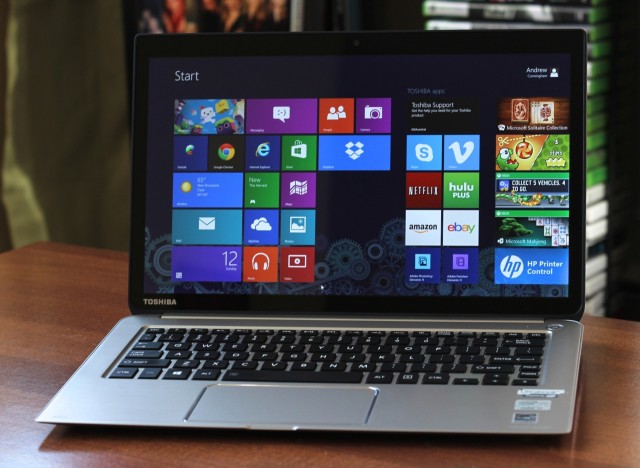
High-resolution, high-density screens are expected on most high-end phones and tablets today. Everything from the iPhone 5 to the Samsung Galaxy S 4 to the Nexus 10 is trying to pack as many pixels as it can into a given screen size to increase the sharpness of on-screen text and images.
You often hold a phone or tablet pretty close to your face, so the benefits of a high-resolution, high-density display are easy to see. Perhaps it makes sense then that the technology hasn't been picked up as quickly in laptop computers. To date, there have only been a few serious contenders: Apple's 15-inch and 13-inch Retina MacBook Pros, Google's Chromebook Pixel, and now Toshiba's Kirabook.
We're sure that more high-density Windows laptops are on the way, but the Kirabook is the first to make it to market. The laptop raises some natural questions: Does a computer that is both thinner and lighter than the Pixel and the Pros skimp on battery life to achieve these feats? Is the Kirabook good enough to justify its jaw-dropping $1,599.99 starting price? Most importantly, can Windows support high-density displays as well as OS X, Chrome OS, iOS, Android, and others can?
Body and build quality
| Specs at a glance: Toshiba Kirabook | |
|---|---|
| Screen | 2560×1440 at 13.3" (221 ppi) |
| OS | Windows 8 Pro 64-bit |
| CPU | 2.0GHz Intel Core i7-3537U (Turbo up to 3.1GHz) |
| RAM | 8GB 1600MHz DDR3 (non-upgradeable) |
| GPU | Intel HD Graphics 4000 (integrated) |
| HDD | 256GB solid-state drive |
| Networking | 802.11n (2.4GHz only), Bluetooth 4.0 |
| Ports | 3x USB 3.0, HDMI, card reader, headphones |
| Size | 12.44" × 8.15" × 0.7" (315.98 × 207.01 × 17.78mm) |
| Weight | 2.97 lbs (1.35kg) |
| Battery | 3380 mAh |
| Warranty | 2 years |
| Starting price | $1,599.99 |
| Price as reviewed | $1,999.99 |
| Other perks | Webcam, backlit keyboard |
The 2.97-pound Kirabook crams the high-density display of a laptop like the Retina MacBook Pro (3.57 pounds) or Chromebook Pixel (3.35 pounds) into something that weighs about as much as the 13-inch MacBook Air. It's a bit thicker than some other Ultrabooks (0.7" compared to 0.5" for Acer's Aspire S7), but it's still light and very easy to carry around in a bag.
Most laptops today are either rectangles or gently rounded rectangles, but the Kirabook splits the difference. Its back corners are rounded and its front corners aren't. This is a simple design touch, but it helps to make the Kirabook easier to identify at a glance. Like other Ultrabooks, it uses a tapered design that's thicker in the back of the laptop (where the system components and fan are located) and thinner in the front, which angles the keyboard slightly toward the user.
The laptop's construction is partly "magnesium alloy" and partly plastic. The lid, palm rest, and keyboard area is all made of a lightly brushed gray metal, while the bottom case is made of plastic that has the same color but no brushed-metal texture. Four round, rubber feet on the bottom of the laptop are also joined by the stereo speaker grilles. The positioning means that sound is amplified slightly by a hard surface like a desk or table but muffled slightly by a soft surface like a couch or lap—either way, the sound quality is as middling as we've come to expect from most Ultrabooks. There's a bit of distortion at higher volume levels.
Update: Toshiba tells us that the bottom of the laptop is also made of magnesium alloy and not plastic—it looks and feels more like plastic than either the lid or the palm rest, but they're apparently the same material. I'm told that the lid is pressed magnesium alloy and that the bottom of the laptop is die cast, which accounts for the differences in how they feel.
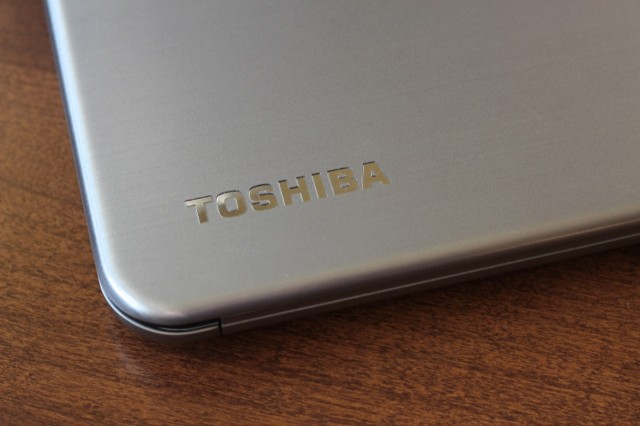

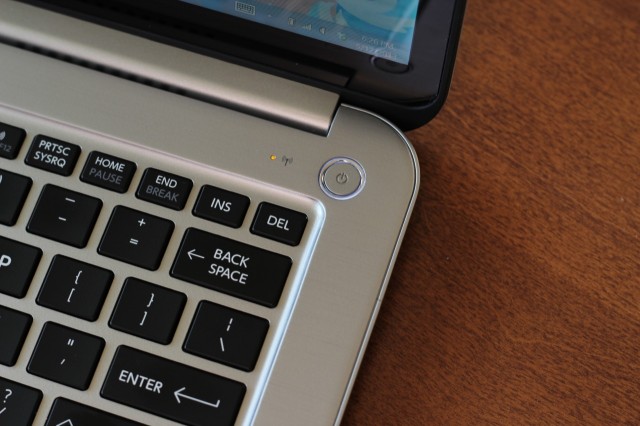
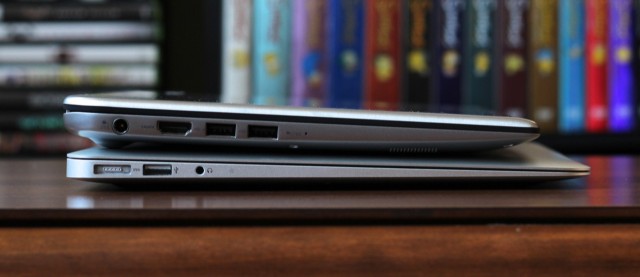
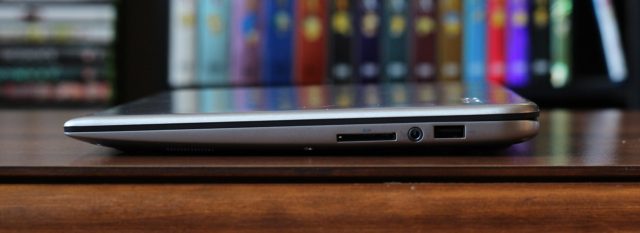
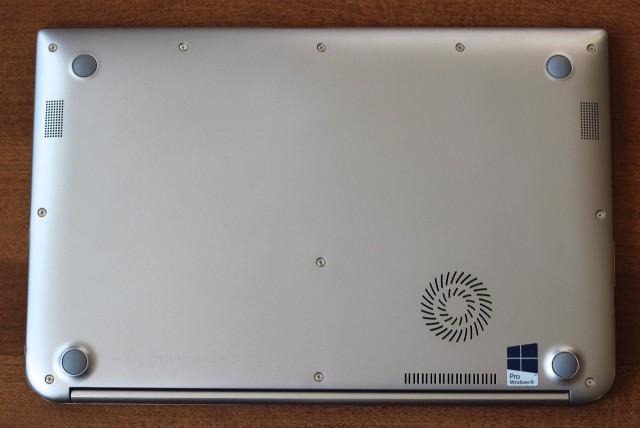
There are also two fan vents on the bottom of the laptop, both used for the laptop's single fan. During light and general use, fan noise isn't a problem—in a room with light ambient noise the laptop is essentially silent. It's when the hardware starts straining that things get less pleasant. As the device picks up speed its fan sounds more and more like a vacuum cleaner.
Finally, the Kirabook has a nice selection of ports for a laptop of its size: three USB 3.0 ports (two on the left and one on the right—one of which can be used to charge a device when the laptop is asleep), a full-size HDMI port, a card reader, and a headphone jack.
Keyboard and trackpad
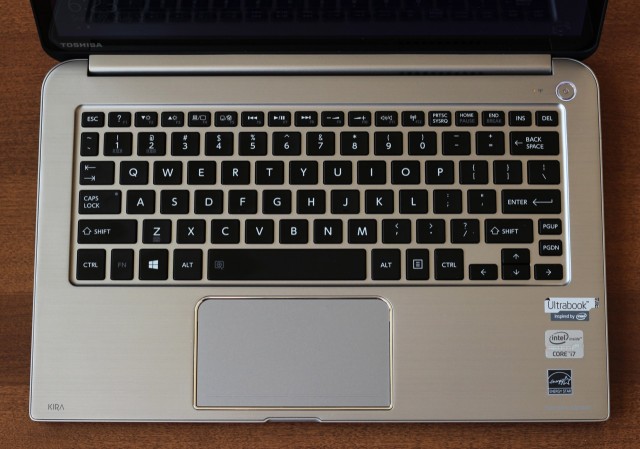
The Kirabook's keyboard shares similarities with past Toshiba keyboards, but overall the layout is an improvement over what we've seen from the company in the past. Most of the keys are just a bit shorter than they are in other keyboards, but they're just as wide—instead of being square, they're ever-so-slightly rectangular. The bottom row of keys (which includes the spacebar) is slightly taller, and the top row (the function keys, delete key, and a few others) is a little shorter and narrower. Arrow keys are half-height, as they often are in Ultrabooks. The key sizing and arrangement is very easy to get used to if you're coming from any other chiclet keyboard, and I was quickly able to type at my normal speeds.
The quality of the keyboard is also an improvement. Travel is good, and the keys are nice and firm—the mushiness we noticed on last year's crop of Toshiba Ultrabooks is entirely absent. Where the old Toshiba keys were also entirely flat, the Kirabook's are gently scooped to better fit your fingers. The keyboard's backlight is also bright and even. It's important to get the keyboard right when you're making a laptop, and the Kirabook got it right where other Toshiba Ultrabooks have failed.
The trackpad shares its shape with the laptop itself. The top edges are curved and the bottom edges are squared off. Aside from this thoughtful design touch, the trackpad is very much like all the other trackpads we've been seeing in Windows laptops lately. It's a single, clickable piece of plastic with a textured surface that supports multiple touch points. Basic gestures like two-fingered scrolling and pinch-to-zoom work as intended, as do the Windows 8 trackpad gestures. We had no issues with palm rejection. Some specific applications (Chrome, we're looking at you) had trouble with scrolling, but we're more inclined to blame that on Chrome than the Kirabook since other applications were fine.
The screen
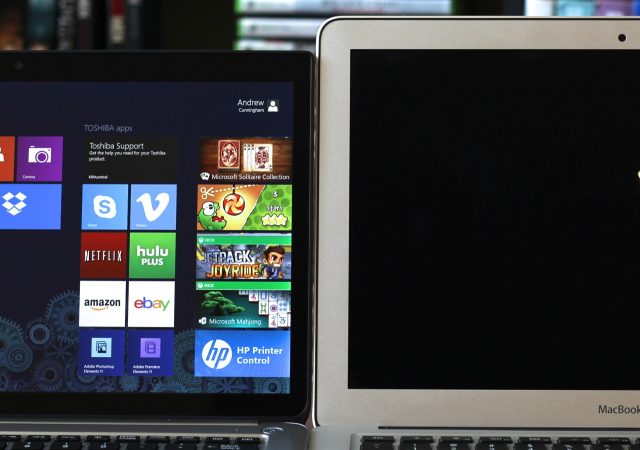
The build quality and design of the Kirabook are generally excellent, but the screen is the real star of the show. At 221 ppi, its 13.3-inch 2560×1440 screen is playing in the same ballpark as the Retina MacBook Pros and the Chromebook Pixel. While it's not the first computer to market with this kind of a screen, it's the first Windows PC to include one (we'll talk more about how Windows handles the pressure in a moment).
The display itself is bright and colorful and, as is to be expected, optimized text and images look very crisp. Its viewing angles are worse than what we've seen in other high-end PCs of late, though; colors shift and you'll notice the screen washing out if you bend the screen toward yourself at a 70 or 80 degree angle. The screen doesn't become unusable unless you're looking at it from an extreme angle, but it's not quite as good as either the Pixel or the Retina MacBook Pros. The hinge is stiff enough that the screen doesn't wobble too much when you reach out to touch it, but not so stiff that it's impossible to lift the lid with one hand.
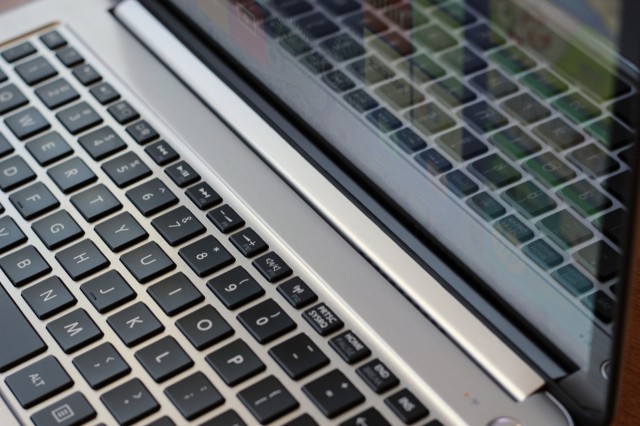
In the higher-priced, $1,799 and $1,999 models, the laptop adds to its list of features a 10-point capacitive touchscreen. The touchscreen uses a layer of Corning's Concore Glass, a scratch-resistant surface which reduces the overall thickness of the screen by integrating the touch layer into the glass itself. This is a bit different from "in-cell" touchscreens we've seen in phones like the iPhone and Galaxy S4, which integrate the touch layer into the LCD display rather than the glass itself (for more information about how modern capacitive touch works, see this article). Corning's marketing materials for Concore imply that its solution is better-suited to larger surfaces, but in both cases the implementation is similar: reduce thickness by integrating the touch layer into one of the others.
We spent some time navigating the OS, tapping and swiping various onscreen elements and playing games. We noticed no particular problems with the screen on our review unit. The screen picks up fingerprints and smudges (a sad but inevitable fact of life with gadgets) but my fingers glide across it without any undue resistance. The glass layer does make the screen extremely reflective, though.
reader comments
110